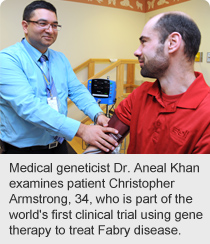
January 24, 2013
CALGARY – A home care nurse visits Christopher Armstrong every two weeks to administer a medication that allows the 34-year-old Calgarian to maintain a good quality of life. (view video)
Armstrong is one of about 400 Canadians who have Fabry disease, an inherited enzyme deficiency that can shorten the lifespan of people who have it by as much as 40 years.
 Although the twice-monthly Enzyme Replacement Therapy infusions help manage his illness, they aren’t a cure and they’re something he has to organize his life around.
Although the twice-monthly Enzyme Replacement Therapy infusions help manage his illness, they aren’t a cure and they’re something he has to organize his life around.
“Even if I had to come in once every six months for Enzyme Replacement Therapy, instead of every two weeks, then it would still be another step toward living a normal life,” Armstrong says.
Now researchers in Calgary have launched the first gene therapy clinical trial in the world for Fabry disease that could ultimately lead to a permanent cure.
People with Fabry disease have a change in a gene called GLA and can’t make enough enzyme to break down a fatty substance called Gb3. The build-up of Gb3 can lead to problems in the kidneys, heart and brain.
Researchers will first remove a quantity of stem cells from a Fabry patient’s blood. Then a working copy of a new gene will be inserted into the stem cells using a specially engineered virus. During the final phase of the trial, researchers hope to transplant these stem cells back into the donor patient and the new, working copy of the gene will make the missing enzyme.
The clinical trial has been prompted by promising gene therapy results in mice performed in the laboratory of Dr. Jeffrey Medin at the University Health Network in Toronto. Dr. Medin is the principal investigator of the pan-Canada team grant that is supporting this trial.
“We hope this will one day become a form of treatment that effectively cures Fabry disease,” says Dr. Aneal Khan, a medical geneticist based at Alberta Children’s Hospital, who is leading the Calgary segment of the national project.
“It could also help establish a platform on which we can create gene therapies for other illnesses and establish Calgary as a national leader in this experimental field of interventional genetics.”
Although several gene therapies have been used in Canada for cancer, this study will be the first in the country to test a gene therapy for an inherited metabolic disorder.
Although the project is headquartered in Toronto, physicians and scientists in Calgary will play a major role in the clinical trial. In particular, the lab at Foothills Medical Centre in Calgary has specialized expertise in the stem cell filtering process that will be used for the clinical trial.
“The trigger that’s making all this possible is Calgary’s expertise in isolating the specific blood stem cells we need,” says Dr. Medin. “Without a sufficient quantity of those stem cells to work with, our likelihood of success would be greatly reduced.”
In the Fabry trial, technologists led by Dr. Nicole Prokopishyn, director of the Calgary Laboratory Services Cellular Therapy Lab, processed the blood from a donor patient and isolated a specific type of stem cell called a CD34+ cell.
Armstrong recently donated his blood for key initial experiments for the first phase of the trial. Nearly a billion of Christopher’s CD34+ cells have been isolated and will be sent to Dr. Medin’s lab in Toronto. Dr. Medin’s team will take those cells and, using a modified virus, insert a working copy of the GLA gene into the stem cells.
“We use a type of virus called a lentivirus, which has been modified in a couple of critical ways,” says Dr. Medin, who is also a professor in the Department of Medical Biophysics at the University of Toronto. “First, it’s been stripped of any of its disease-causing capability and is safe. Second, it has the corrected functional GLA gene, which will cause the donor cells to make the correct enzyme. When the corrected cells circulate in the blood, they also secrete the enzyme, which is then taken up by unmodified cells. This effectively extends the therapy afforded by the modified stem cells.”
The corrected cells go back into the donor patient, meaning there is less likelihood for rejection compared to cells coming from a different individual.
In the current pre-clinical phase of the study, researchers hope to demonstrate Armstrong’s corrected stem cells are able to provide a source of enzyme in a specially adapted mouse that has Fabry disease. After this is accomplished, the second phase will repeat the experiment using a new donor with all the checks and balances needed for a human trial. Once the pre-clinical experimental results have satisfied the regulatory requirements of Health Canada, the team aims to treat the first human Fabry disease patient, which they estimate will be within two years.
The project is being funded by the Canadian Institutes of Health Research and the Kidney Foundation of Canada.